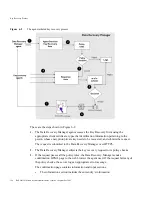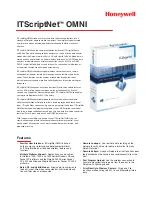
Key Recovery Process
Chapter 6
Data Recovery Manager
193
Key Recovery Agents and Their Passwords
Key recovery agents
have the authority to retrieve end-entity’s encryption private keys. The
recovery agent’s role can be performed by any person in your organization. As system
administrator, you can designate one or more individuals to be key recovery agents. These
individuals need to do the following:
•
They must specify a secure password, which in combination with other recovery
agents’ passwords will be used for protecting the database in which the Data Recovery
Manager stores end-entity’s keys. You facilitate this by allowing each recovery agent
to enter a password in the Data Recovery Manager during configuration.
•
They must be available to retrieve your end-entity’s encryption private keys if the need
arises. It isn’t necessary for all key recovery agents to be available for the key recovery
operation. You specify how many agents are required to authorize the recovery of a
key; see “Key Recovery Agent Scheme” on page 198. However, the specified number
of key recovery agents must all provide their passwords at the same time to authorize
the recovery of a specific key.
The first time you create key recovery agents and specify their passwords is during the
installation of the Data Recovery Manager. However, you can change the number of
recovery agents and their passwords later by modifying it in the Data Recovery Manager
configuration; see “Changing Key Recovery Agents’ Passwords” on page 201.
Secret Sharing of Storage Key Password
The Data Recovery Manager uses the private key of its
storage key pair
to encrypt the
end-entity’s encryption private keys. This requires that the storage key be well protected.
For the protection of the storage key pair, the Data Recovery Manager supports a
password-splitting mechanism called
m of n secret splitting or sharing
, whereby it splits the
PIN that protects the token in which the storage key pair resides among
n
number of key
recovery agents and reconstructs the PIN only if
m
number of recovery agents provide their
individual passwords;
n
must be an integer greater than 1 and
m
must be an integer less than
or equal to
n
.
Here’s how the
m
of
n
secret splitting mechanism gets built and works:
During the installation of a Data Recovery Manager, you generate the storage key pair and
specify the hardware token in which the key pair is to be stored. At this time, the system
generates a PIN and splits it into
n
pieces to protect the token, the total number of key
recovery agents (
n
), and how many of these agents (
m
) are required to perform a key
recovery operation. You can change the
m
of
n
secret splitting later; for details, see “Key
Recovery Agent Scheme” on page 198.
Summary of Contents for CERTIFICATE 7.1 ADMINISTRATOR
Page 1: ...Administrator s Guide Red Hat Certificate System Version7 1 September 2005 ...
Page 22: ...22 Red Hat Certificate System Administrator s Guide September 2005 ...
Page 128: ...Cloning a CA 128 Red Hat Certificate System Administrator s Guide September 2005 ...
Page 368: ...ACL Reference 368 Red Hat Certificate System Administrator s Guide September 2005 ...
Page 460: ...Constraints Reference 460 Red Hat Certificate System Administrator s Guide September 2005 ...
Page 592: ...CRL Extension Reference 592 Red Hat Certificate System Administrator s Guide September 2005 ...
















































